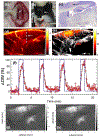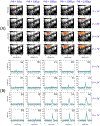Imaging the response to deep brain stimulation in rodent using functional ultrasound
- PMID: 33482648
- PMCID: PMC7920924
- DOI: 10.1088/1361-6560/abdee5
Imaging the response to deep brain stimulation in rodent using functional ultrasound
Abstract
In this study, we explored the feasibility of using functional ultrasound (fUS) imaging to visualize cerebral activation associated with thalamic deep brain stimulation (DBS), in rodents. The ventrolateral (VL) thalamus was stimulated using electrical pulses of low and high frequencies of 10 and 100 Hz, respectively, and multiple voltages (1-7 V) and pulse widths (50-1500 μs). The fUS imaging demonstrated DBS-evoked activation of cerebral cortex based on changes of cerebral blood volume, specifically at the primary motor cortex (PMC). Low frequency stimulation (LFS) demonstrated significantly higher PMC activation compared to higher frequency stimulation (HFS), at intensities (5-7 V). Whereas, at lower intensities (1-3 V), only HFS demonstrated visible PMC activation. Further, LFS-evoked cerebral activation was was primarily located at the PMC. Our data presents the functionality and feasibility of fUS imaging as an investigational tool to identify brain areas associated with DBS. This preliminary study is an important stepping stone towards conducting real-time functional ultrasound imaging of DBS in awake and behaving animal models, which is of significant interest to the community for studying motor-related disorders.
Conflict of interest statement
Disclosure of conflict of interest
The authors have no financial interest to disclose related to the content of this article.
Figures





Similar articles
-
Frequency-dependent functional neuromodulatory effects on the motor network by ventral lateral thalamic deep brain stimulation in swine.Neuroimage. 2015 Jan 15;105:181-8. doi: 10.1016/j.neuroimage.2014.09.064. Epub 2014 Oct 14. Neuroimage. 2015. PMID: 25451479 Free PMC article.
-
Spatiotemporal dynamics of cortical perfusion in response to thalamic deep brain stimulation.Neuroimage. 2016 Feb 1;126:131-9. doi: 10.1016/j.neuroimage.2015.11.017. Epub 2015 Nov 11. Neuroimage. 2016. PMID: 26578359
-
Frequency-dependent spike-pattern changes in motor cortex during thalamic deep brain stimulation.J Neurophysiol. 2020 Nov 1;124(5):1518-1529. doi: 10.1152/jn.00198.2020. Epub 2020 Sep 23. J Neurophysiol. 2020. PMID: 32965147 Free PMC article.
-
Orientation-selective and directional deep brain stimulation in swine assessed by functional MRI at 3T.Neuroimage. 2021 Jan 1;224:117357. doi: 10.1016/j.neuroimage.2020.117357. Epub 2020 Sep 9. Neuroimage. 2021. PMID: 32916285 Free PMC article.
-
Changes in cortical excitability with thalamic deep brain stimulation.Neurology. 2005 Jun 14;64(11):1913-9. doi: 10.1212/01.WNL.0000163985.89444.DD. Neurology. 2005. PMID: 15955943
Cited by
-
Mapping Pharmacologically Evoked Neurovascular Activation and Its Suppression in a Rat Model of Tremor Using Functional Ultrasound: A Feasibility Study.Sensors (Basel). 2023 Aug 3;23(15):6902. doi: 10.3390/s23156902. Sensors (Basel). 2023. PMID: 37571686 Free PMC article.
-
Background Noise Removal in Non-Contrast- Enhanced Ultrasound Microvasculature Imaging Using Combined Collaborative, Morphological, and Vesselness Filtering.IEEE Access. 2024;12:116150-116161. doi: 10.1109/access.2024.3446531. Epub 2024 Aug 20. IEEE Access. 2024. PMID: 40292271 Free PMC article.
-
[The developments and applications of functional ultrasound imaging].Sheng Wu Yi Xue Gong Cheng Xue Za Zhi. 2022 Oct 25;39(5):1015-1021. doi: 10.7507/1001-5515.202206050. Sheng Wu Yi Xue Gong Cheng Xue Za Zhi. 2022. PMID: 36310491 Free PMC article. Review. Chinese.
-
Theta-frequency medial septal nucleus deep brain stimulation increases neurovascular activity in MK-801-treated mice.Front Neurosci. 2024 Mar 15;18:1372315. doi: 10.3389/fnins.2024.1372315. eCollection 2024. Front Neurosci. 2024. PMID: 38560047 Free PMC article.
References
-
- Grill WM, Snyder AN and Miocinovic S 2004. Neuroreport 15 1137–1140 - PubMed
-
- McIntyre CC, Savasta M, Walter BL and Vitek JL 2004. Journal of clinical neurophysiology 21 40–50 - PubMed
-
- Jackson A and Zimmermann JB 2012. Nature Reviews Neurology 8 690. - PubMed
-
- Benabid AL, Chabardes S, Mitrofanis J and Pollak P 2009. The Lancet Neurology 8 67–81 - PubMed
Publication types
MeSH terms
Grants and funding
LinkOut - more resources
Full Text Sources
Other Literature Sources
